
 Amit U Jain, IT Specialist, Hosconnn, goes candid in saying Health ITin India is predominantly HIS driven
Amit U Jain, IT Specialist, Hosconnn, goes candid in saying Health ITin India is predominantly HIS driven
What are the components of Health IT? Which one is the strongest? Kindly support your opinion with facts & figures.
Health IT in India is predominantly HIS driven. In the Indian context, in the absence of basic regulations and legislation for EMR/EHR, HIS fits in the scenario in a better manner. Most of the hospitals prefer deploying HIS aka mini ERPs for hospitals which not only handles patient related financial data but also data relevant to demographic details, clinical data, diseases classification (ICD-10), internal patient movement, turn-around-time (TAT), time at Point of Service (PoS), Patient Care Cycle (PCC), Internal Customer Audits.

What are the new trends of Health IT in India? What are the new developments that have happened in this field?
Electronic Prescription Pad (EPP): To write prescriptions on ordinary paper and a digital copy saved on software for future reference and retri. Radio Frequency Identification (RFID) is a wireless technology used for transmitting the identity of person, object, or entity in the form of a unique serial number from one device to another. RFID will give HIS to track and match the right patients with the right procedures. This helps reduce malpractice by eliminating human errors. It may be a combination of real time locating systems such as: tracking the equipment,patient location, and tracking ofmedications being administered.
What are the top five strengthsand weaknesses of IndianHealth IT?Kindly explain.
Five strengths are fresh and unbiasedapproach of key stakeholders, ease of adaptability in new setups, increased awareness at various stakeholder levels, availability of IT resources not only in metros, but even in tier II and III cities / towns, in person support to software customer. Weaknesses are lack of legislation for maintaining EMR/ HER, lack of regulatory authority for quality standards in Health IT, lack of IT training in medical curriculum, health insurance still in nascent stage, catering only to the creamy layer and resistance to new technology adaption at the level of software customers.
| We provide thefollowing solutions toIndian healthcare >>Hospitals / Nursing HomesSoftware >>Doctors Boutique ClinicsSoftware >>Pathology Laboratories &Diagnostic Centers Software >>Blood Banks Software >>Specialised MediclaimModules |
In providing solutions to hospitals and to others, what kind of challenges you face? What are your suggestions to improve it?
I feel there is a lot of ambiguity pertaining to expectations from the management and software customers in the hospital, lack of acceptance and appreciation of computerisation by medical, paramedical and other healthcare specialists, lack of standards in hospitals functioning leading to over customisation of the software according to the needs and practices of the hospital, Perception of IT as low priority area, resulting to miniscule budget for implementing HIS are some very challenging areas for us. To improve the scenario I think IT training should be a part of medical / paramedical training programmes / curriculum, IT should be perceived as an investment rather than cost.

Be a part of Elets Collaborative Initiatives. Join Us for Upcoming Events and explore business opportunities. Like us on Facebook , connect with us on LinkedIn and follow us on Twitter , Instagram.












